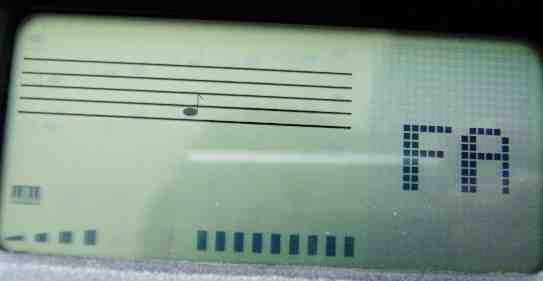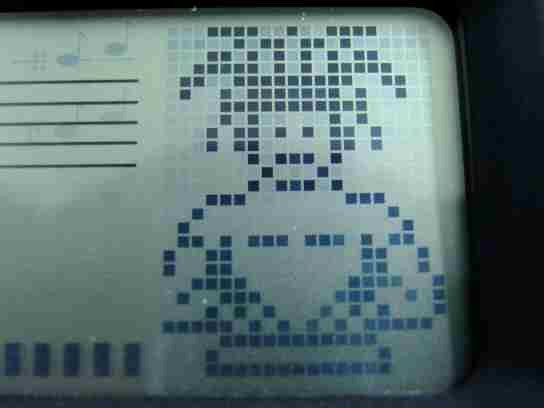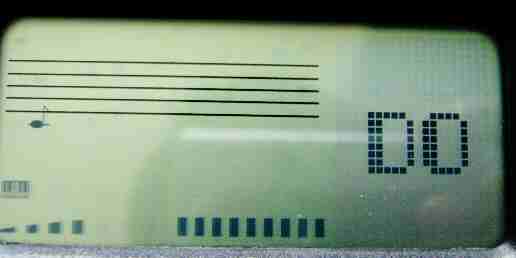 (bad smelling toy keyboard with nice LCD animations, rhythms & wonderful
demos)
(bad smelling toy keyboard with nice LCD animations, rhythms & wonderful
demos)
This quite big toy tablehooter smells awful of toxic solvents (styrene?). The hardware is one of the many My Music Center successors and although the CPU is 4 note polyphonic, only 2 notes can be reliably played due to missing key matrix diodes. The preset sounds are rather boring.
Its special feature is the LCD, which in the left section displays individual musical notes (similar like key lighting) and in the right section displays lots of nice Tamagotchi- style pixel animations during its great demo tunes. Don't expect anything spectacular of the large scratch disc; it only plays 2 simple samples (fixed pitch, one per direction, repeated every 120°) those can be selected by 5 OBS buttons. The mechanism under the disc looks like a built-in self- destruction mechanism, because it has wedges those simply rub on 3 bare(!) silicone rubber buttons, only lubricated with some kind of (toxic odours emitting?) grey grease - I doubt that they would last really longer than a pencil eraser so far you don't modify them.
 |
 |
 The
keyboard shown on the box seems to be a prop; e.g. the drumpad rims are
missing and also the guy on the LCD doesn't exist on the real instrument. The
keyboard shown on the box seems to be a prop; e.g. the drumpad rims are
missing and also the guy on the LCD doesn't exist on the real instrument. |

The Play 'n' Jam keyboard generally sounds and behaves quite much like My Music Center, but like the Chicco - Sing 'n' Dance Orchestra it is 4 note polyphonic and has a different sound set with quite boring main voice preset sounds. The LCD always shows the currently played note and its name, but with polyphonic play it only recognizes the last note; the key lighting of my Sing 'n' Dance Orchestra responds polyphonic instead. A bit annoying is the "auto power- off" feature, which mutes the instrument with a quiet short beep when no key is pressed for a minute and then delays the next note while it comes up again with a popping noise and resets the preset sound to "piano" the next note. During each key press 2 LEDs (red and green, wired parallel) light up above the scratch disk; with rhythm they work as tempo LEDs.
The preset sounds have the same gritty synthetic lo-fi chorus style like My Music Center, but are programmed differently and rather boring, because most lack the characteristic detuned chorus effect. The "piano" has no chorus and sounds very static (just a waveform with decay envelope). The "organ" resembles a metal pipe organ rank with chorus and sounds like on Sing 'n' Dance Orchestra; "flute" sounds similar, but duller and with less percussive attack phase. The "trumpet" resembles more an oboe (no chorus). The "music box" sounds like on Sing 'n' Dance Orchestra. The "guitar" has some chorus, resembles an acoustic one (like on Sing 'n' Dance Orchestra). The "violin" is just a waveform with neither chorus nor vibrato and resembles an oboe; "saxophone" is the same sound with chorus (thus sounding more violin- like).
The 8 rhythms are switched on by individual OBS buttons; annoying is that rhythms always start with their default tempo and running fixed- key accompaniment (which can be muted with the "chord" button). During each rhythms a corresponding cartoon animation sequence repeats on the LCD. The rhythms and drumpads use low- res percussion samples, those sound different than with My Music Center. Beside the normal rhythms there is the "drum" button (LCD shows drumming indian), which starts a latin rhythm and the drumpads play each a furious tribal drum pattern. By unknown reasons only monophonic melody play is possible in this mode.
The scratch disc plays only 2 samples (one per direction, repeated every 120° of rotation) without any pitch change or other fancy features. There are 5 sets of each 2 samples assignable to the disc through OBS buttons, but they only use 5 different samples in total. "guitar" is a distorted e-guitar hit. "scratch low" resembles an orchestra hit, "electric sound" resembles a short siren (a high followed by a low tone).
The "guide" mode is similar like key lighting; when its button is pressed during a demo melody, the melody voice stops and the next note appears on the LCD while the accompaniment of that tune repeats in a loop until you hit the correct key; then the next note appears with its accompaniment and so on. The "one key" button starts a very similar mode, except that here the instrument doesn't care if you hit the correct key.
The cartoon animations are quite nice and versatile, although many repeat in a jerky loop; the graphics quality resembles much a Tamagotchi (LCD matrix of 20*26 pixels in B/W, no grey scale). While the rhythms mainly show different dancers or musicians, there are also some odd animations; e.g. "swing" shows a hopping pig, "slow rock" a waving palm tree. The demo melodies show animations corresponding to the song topic (xmas things etc.).
 |
 |
|
|
|
|
 |
|
|
|
|
|
|
|
|
|
|
|
|
|
|
|
|
|
circuit bending detailsThe hardware of the Play 'n' Jam keyboard consists of 8 small PCBs interconnected by grey ribbon cables. Many capacitors are replaced by 2 different caps in series; apparently this thing was manually soldered together from spare parts as Chinese concentration camp piecework or the like. It badly smells of toxic styrene or a similar solvent, thus I inserted a smell absorber into the case. The foam rubber must be well wrapped into thin handkerchief paper or a similar porous material because the carbon it conducts electricity and would short the electronics when it loosely rumbles around.On the main CPU PCB transistors reduce the +6V supply voltage to +4.5V. Important is that the CPU crashes during power- up when the voltage is reduced further, thus if you need to add a diode into the battery compartment line for installing an AC- adapter jack, only use a Schottky diode. The transistor Q2 seems to control the amplifier supply voltage for the standby mode. To add a pitch control, the positive reference voltage at the potentiometer needs to be taken from the CPU pin between resistor R7 and R8, because otherwise the sound howls. LCD display:The main CPU "U1 64A-44" controls the independent display CPU "U3 61A-13" through only 2 lines (CD1 and CD7 - possibly an I²C- port). The display CPU has its own crystal oscillator, thus there is no risk of damaging the LCD by DC voltage from a crashed main CPU. When the main CPU is underclocked too much, the display only flickers with 1Hz (likely an attempt to re-sync with the CPU). When the main CPU is overclocked/ shitshot, it simply shows wrong animations, but never makes pixel mess or similar crash stuff, thus apparently the main CPU only sends simple animation scene numbers to the display CPU, which displays the animation completely autonomously from its internal ROM.fix keyboard matrix flaws:The key matrix outputs are {AB0..AB7, CD0}, the inputs {EF0..EF7}; the inputs are active- high (react on +Vs) and the matrix has no eastereggs. Especially with empty batteries the scratch disk and drumpads tend to cause note mess etc. due to too sensitive matrix input lines. Solder an 18 kOhm pulldown resistor from each EF* input line to GND to fix this. Very annoying and awkward to fix is that the keyboard has no matrix diodes, which makes note mess when more than 2 keys are pressed simultaneously. To fix this, a diode needs to be soldered into the line of each individual key (facing from output to input). You have to cut many traces for this and connect the diodes with thin coil wire, and this in a way that the keyboard PCB still fits into the case. (I had to cut out parts of the plastic rail under the keys to make it fit.) The keys use the output lines {AB0..AB3} and all 8 input lines. Also the drumpads should be equipped with such diodes.preserve the scratch disc:The scratch disc operates 3 button switches in a sequence, those control a 4066 IC that outputs pulses through capacitors(?) to the keyboard matrix (connecting AB7 with {EF0..EF2}). The mechanism under the disc looks like a built-in self- destruction mechanism, because it has wedges those simply rub on 3 bare(!) silicone rubber buttons those are only lubricated with some kind of (toxic odours emitting?) grey grease - I doubt that they would last really longer than a pencil eraser so far you don't modify them. (My Casio SA-40 has abrasion resistant plastic buttons between disc and rubber contacts.) To protect them, cut a ring out of thick plastic foil (e.g. from transparent packaging or folder material) and mount it between disc and contacts in a way that the disc now only rubs on the plastic foil surface and doesn't raze on the rubber buttons anymore. (Don't use PVC foil, because the plasticizer in it may dissolve the rubber over time.)Attention: I have only very incomplete draft schematics of my modification, thus this description might be partly inaccurate or even wrong since it is based on them. |
The 8 demo melodies are lovely orchestrated and show nice animations on the LCD:
According to the selection of demo tunes, preset sounds and various
hardware details this instrument seems to be a close relative of the nice
Chicco
- Sing 'n' Dance Orchestra, although the latter has way less flaws
and doesn't odour of styrene. Otherwise the latter plays no accompaniment
in "guide" mode, thus it may be the predecessor of this hardware.
| removal of these screws voids warranty... | ||
 |
||
|
|